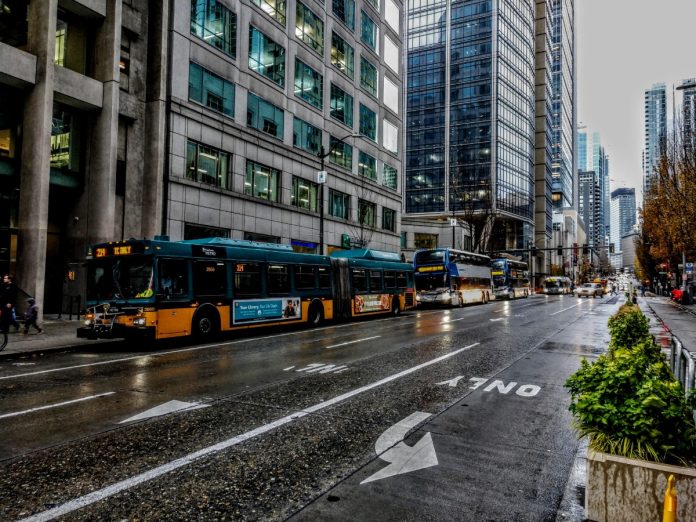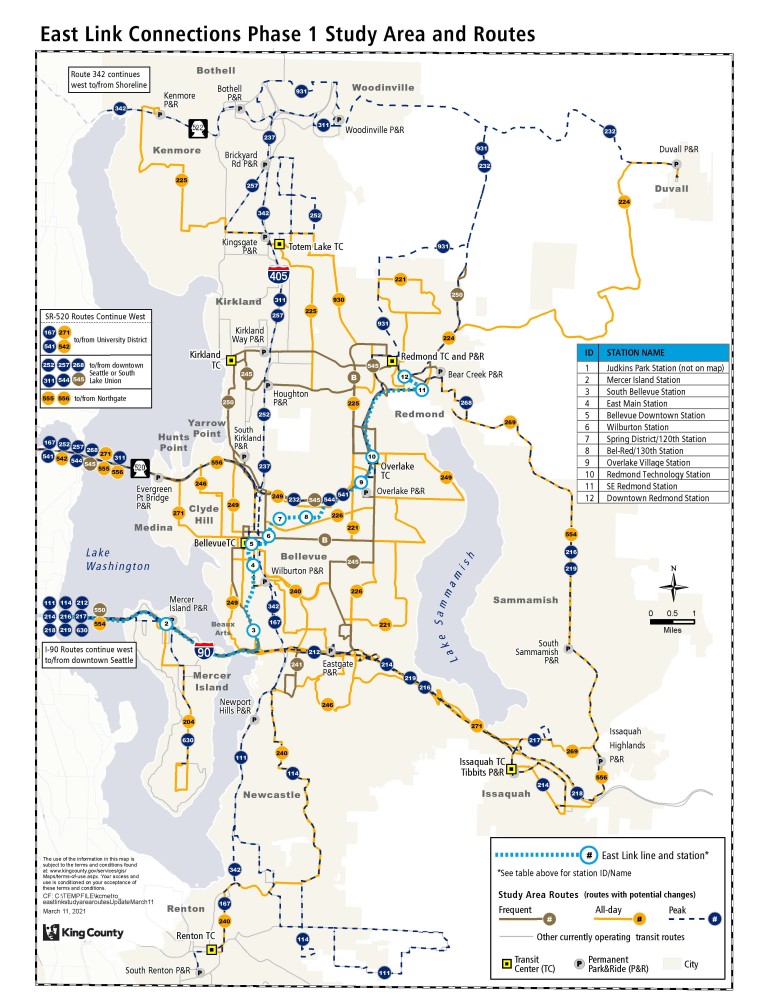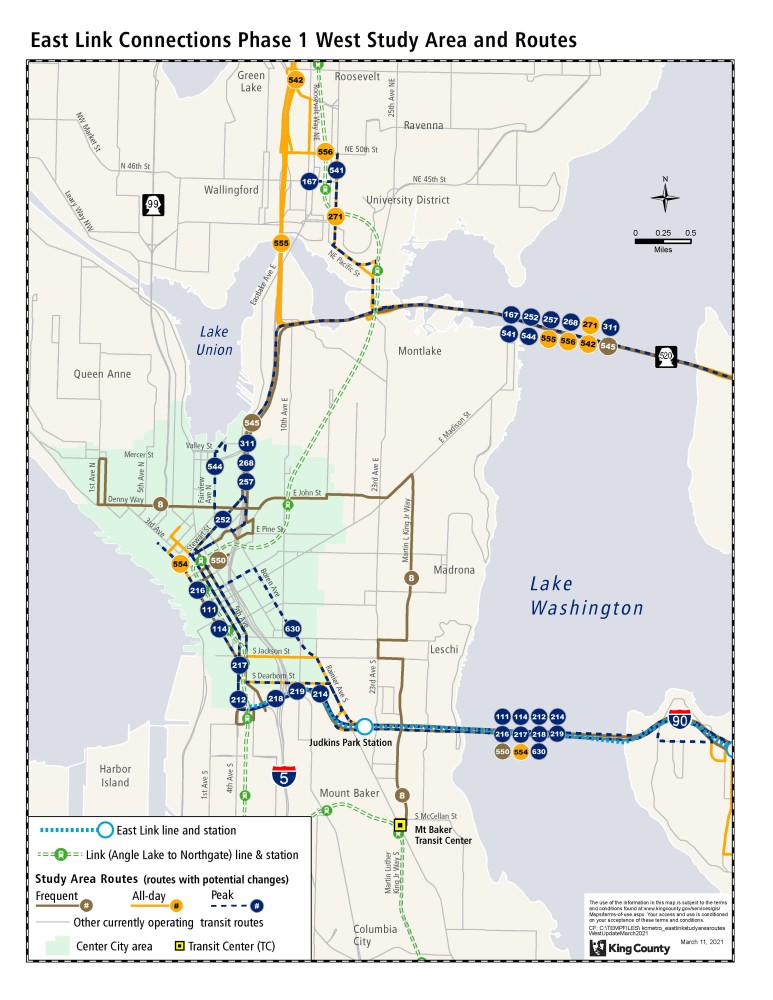With the arrival of light rail on the Eastside soon, King County Metro is beginning a process to restructure bus service to better integrate with East Link and Downtown Redmond Link. The bus restructure could affect some 42 routes that operate on and from the Eastside and near the new Judkins Park Station in Seattle. On the Eastside, cities as far north, south, and east as Bothell, Renton, and Duvall are a part of the Phase 1 Study Area. The initial phase of the study is a survey of riders and residents who could be affected by any bus network changes.
Routes in the study are both Metro and Sound Transit services that operate near future light rail stations or overlap light rail corridors. Some services like local Routes 230 and 240 are not included in the study since they will be unaffected by the introduction of light rail. This also applies to some I-405 bus routes and flexible mobility services. However, the 42 bus routes under review for changes, include Routes 8, 111, 114, 167, 204, 212, 214, 216, 217, 218, 219, 221, 224, 225, 226, 232, 237, 240, 241, 245, 246, 249, 250, 252, 257, 268, 269, 271, 311, 342, 541, 542, 544, 545, 550, 554, 555, 556, 630, 930, and 931 as well as the RapidRide B Line.
A concern that might be pressing to riders and policymakers is whether or not the Eastside bus restructure may emulate the Northgate Link bus restructure. The restructure eliminated Route 41 and largely moved its service hours out of the service area. Route 41 operated from Northgate to Downtown Seattle via I-5 essentially mimicking the express nature of the Northgate Link Extension to Downtown Seattle. The implication there is that a net sum of service hours were pulled out rather than reinvested in the service area, leaving fewer service hours to do the critical work with in improving local bus service.
On the other hand, those hours may get a higher return in terms of ridership or advancing Metro’s equity goals if they are not strictly limited to the study area. In the pandemic era, bus ridership has been relatively weak on the Eastside and remained strongest in Southeast King County, where more service workers and transit-dependent populations tend to live as opposed to largely office workers.
In a recent meeting, Metro has suggested that this issue could largely be avoided on the Eastside since the agency does not operate much duplicative bus service along the East Link corridor. “The 2021-2022 biennial budget process did not include any assumption about reduction associated with East and Redmond Link extensions because Metro is not the primary all-day service provider for the transit connections that will be most directly replaced by East Link,” an agency report stated.
However, there could be other implications to service levels outside the bus restructure, the report warned. “While Metro’s 2021-22 budget does not reflect a reduction of specific hours from the East Link project area as part of a restructure project,” the report stated. “It is likely that area will be impacted by overall system-wide reductions and adjustments related to long-term revenue capacity and impacts. Therefore, the East Link project area and its cities will likely see a net decrease in Metro bus service hours proposed alongside the increase of Link light rail service as part of system-wide changes.”
Metro laid blame on the possible service reductions due to “anticipated long-term financial impacts and its structural deficit,” but put a positive spin on this by saying that “the Link light rail investment represents a significant increase in overall transit service levels for the project area.” Assistance in the form of federal emergency funding approved for transit operations may blunt some or all of this though.
Still, it does seem that there is some direct overlap with East Link for Metro with Routes 204, 212, and 218, for instance. With the Route 41 precedent in mind, it would seem a similar principle should apply to those routes where their highway-running and Seattle portions completely duplicate East Link. Sound Transit also has have more direct overlap with ST Express routes, so perhaps there will be concepts that directly or partially delete routes and do not replace service hours through the ST Express program. It seems like Route 550, for instance, will be on the chopping block. Yet, there are some Sound Transit routes like Routes 566 and 567 that are not included in the study presumably because they are operated by Pierce Transit.
Through April 25th, Metro has an open online survey seeking feedback from riders on their riding habits and priorities. The information will be used to shape some aspects of a forthcoming initial bus restructure proposal in the summer.
Stephen is a professional urban planner in Puget Sound with a passion for sustainable, livable, and diverse cities. He is especially interested in how policies, regulations, and programs can promote positive outcomes for communities. With stints in great cities like Bellingham and Cork, Stephen currently lives in Seattle. He primarily covers land use and transportation issues and has been with The Urbanist since 2014.





